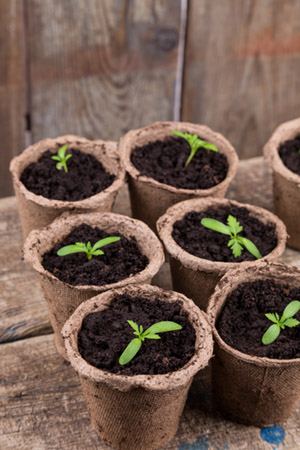Have you ever ended up with a bed of dead flowers, mountains of mulch and a whopping garden center receipt? Let's do something about that, shall we?
Get your gardening groove back with these nine tips.
1. Start with a clean slate
There are two kinds of flowerbeds: Those that have been well-prepared, and those that are covered in weeds.
Give your unplanted bed the once-over. Does it receive enough sunlight? Does water tend to collect there? Have you removed all weeds, roots, and rocks so that your plants will thrive? It's a lot easier to fix these problems now than it is once you’ve planted the flowers and laid the mulch.
2. Start seeds
Start a flowerbed from seed to save money, raise unusual varieties and enjoy the satisfaction of having grown a whole garden from a handful of tiny seeds.
Since some seeds transplant poorly, check the packet and make sure you don't have to sow directly in the ground. Start seeds in trays, pots or in coir pots, using a seedling mixture, place them in a sunny spot, and transplant as soon as they have developed sturdy stems.
3. Prepare nursery plants
Nursery-grown bedding plants give you instant gratification, but the short time between purchase and planting is crucial to their survival.
Pack them closely in your car to avoid damage, and take them home immediately so that they don't fry in your car during other errands.
Water nursery plants as soon as you get home, as often as necessary after that, and a few hours before planting to help their fragile roots survive the trauma of transplanting.
4. Get the winning edge
Even the most carefully planned border can look sloppy without a clearly defined edge. Avoid those inexpensive and quickly deteriorating edges made of plastic, and choose a more natural and long-lasting alternative.
The cheapest solution is to make a shallow trench around the bed with your spade and maintain it throughout the season. For something more refined and permanent, set an edge of brick, concrete or stone in leveling sand. The initial cost may be higher, but they will save you a lot of work and make mowing easier.
5. Plan for the seasons
Choose annuals if you plan on replacing them in a season or two, and plant perennials if you'd like them to last longer. Plant evergreen shrubs or ornamental grasses to provide structure and year-round interest.
Also consider the plant's eventual height: Plant low-growing flowers (usually annuals) at the front of the bed where they can be easily viewed and then replaced at the end of their season.

6. Give them space
Follow the guidelines on the seed packet or plant tag as closely as possible. One that is often overlooked is the amount of space to leave around each plant so they have room to grow. To cover a lot of ground quickly, choose spreading varieties like 'Superbells' and climbing nasturtiums.
7. Dig the perfect hole
Dig each plant's hole to be twice as wide as the original pot, so the roots will have plenty of room to grow. To give them an even better head-start, make a little trench around the inside of the hole so the roots will spread down and out.
This step isn't necessary for annuals, since they won't be around long enough to enjoy their strong root systems, but it is helpful if you have clay soil.
8. Plant it right
When planting transplants and nursery plants, always place them so that their crowns (where the plant meets the soil) are level with the soil in the bed. If the crown is above the soil level, the plant may dry out when soil washes away from the roots. If planted too low, soil will settle around the crown and rot the plant.
Push the soil around the transplant and firmly tamp it in place with a trowel so no gaps are left between the roots.
9. Mulch better
Mulch is essential for conserving moisture and preventing weeds, but one inch is all you need. Established garden beds don't even need mulch because the plants themselves are then capable of protecting the soil.
Avoid landscaping fabric, since it actually keeps moisture from percolating into the soil. Instead, lay down sheets of newspaper before mulching.
Mulches vary by region, but whichever kind you use, follow this one rule: Don't ever pile it up against the plants. They'll rot in no time, and you'll soon have nothing more than an ugly bed of mulch in their place.
Related:
- 40 Great Plants to Grow in Hanging Baskets
- How to Prepare a Vegetable Garden Bed
- A Beginner’s Guide to Choosing Flower Bulbs
from Zillow Porchlight | Real Estate News, Advice and Inspiration http://www.zillow.com/blog/9-tips-planting-flower-bed-196266/
via Reveeo
No comments:
Post a Comment